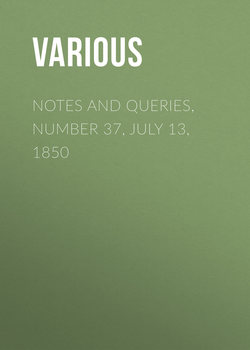Читать книгу Notes and Queries, Number 37, July 13, 1850 - Various - Страница 2
NOTES
CAXTON'S PRINTING-OFFICE
ОглавлениеThe particular spot where Caxton exercised his business, or the place where his press was fixed, cannot now, perhaps, be exactly ascertained. Dr. Dibdin, after a careful examination of existing testimonies, thinks it most probable that he erected his press in one of the chapels attached to the aisles of Westminster Abbey; and as no remains of this interesting place can now be discovered, there is a strong presumption that it was pulled down in making alterations for the building of Henry VII.'s splendid chapel.
It has been frequently asserted that all Caxton's books were printed in a part of Westminster Abbey; this must be mere conjecture, because we find no statement of it from himself: he first mentions the place of his printing in 1477, so that he must have printed some time without informing us where.
With all possible respect for the opinions of Dr. Dibdin, and the numerous writers on our early typography, I have very considerable doubts as to whether Caxton really printed within the walls of the Abbey at all. I am aware that he himself says, in some of his colophons, "Emprinted in th' Abbey of Westmynstre," but query whether the precincts of the Abbey are not intended? Stow, in his Annals (edit 1560, p. 686.), says,—"William Caxton of London, mercer, brought it (printing) into England about the year 1471, and first practised the same in the Abbie of St. Peter at Westminster;" but in his Survey of London, 1603 (edit. Thoms, p. 176.), the same writer gives us a more full and particular account; it is as follows:—
"Near unto this house [i.e. Henry VII.'s alms-house], westward, was an old chapel of St. Anne; over against the which, the Lady Margaret, mother to King Henry VII., erected an alms-house for poor women, which is now turned into lodgings for the singing men of the college. The place wherein this chapel and alms-house standeth was called the Elemosinary, or almonry, now corruptly the ambry, for that the alms of the Abbey were there distributed to the poor; and therein Islip, abbot of Westminster, erected the first press of book-printing that ever was in England, about the year of Christ 1471. William Caxton, citizen of London, mercer, brought it into England, and was the first that practised it in the said abbey; after which time the like was practised in the abbeys of St. Augustine at Canterbury, St. Albans, and other monasteries."
Again, in the curious hand-bill preserved in the Bodleian Library, it will be remembered that Caxton invites his customers to "come to Westmonester into the Almonestrye," where they may purchase his books "good chepe."
From these extracts it is pretty clear that Caxton's printing-office was in the Almonry, which was within the precincts of the Abbey, and not in the Abbey itself. The "old chapel of St. Anne" was doubtless the place where the first printing-office was erected in England. Abbot Milling (not Islip, as stated by Stow) was the generous friend and patron of Caxton and the art of printing; and it was by permission of this learned monk that our printer was allowed the use of the building in question.
The old chapel of St. Anne stood in the New-way, near the back of the workhouse, at the bottom of the almonry leading to what is now called Stratton Ground. It was pulled down, I believe, about the middle of the seventeenth century. The new chapel of St. Anne, erected in 1631, near the site of the old one, was destroyed about fifty years since.
Mr. Cunningham, in his Handbook for London (vol. i. p. 17.), says,—
"The first printing-press ever seen in England was set up in this almonry under the patronage of Esteney, Abbot of Westminster, by William Caxton, citizen and mercer (d. 1483)."
Esteney succeeded Milling in the Abbacy of Westminster, but the latter did not die before 1492. On p. 520. of his second volume, Mr. Cunninghan gives the date of Caxton's death correctly, i.e. 1491.
EDWARD F. RIMBAULT.
